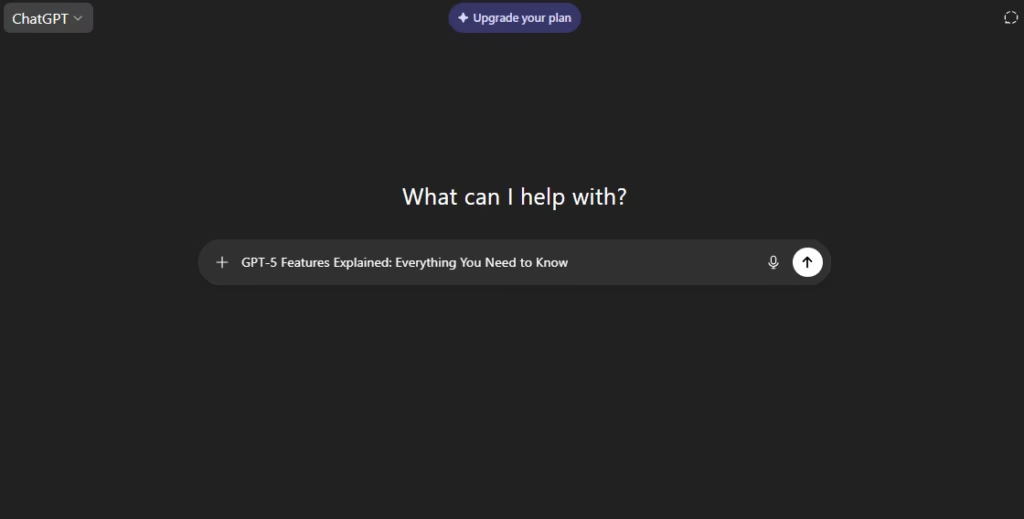GPT-5 Features Explained: Everything You Need to Know

Artificial Intelligence just took another leap forward — and it’s called GPT-5. Whether you’re a developer, business owner, or casual AI enthusiast, understanding the difference between GPT-4 and GPT-5 will help you unlock its full potential.
In this guide, you’ll learn:
- What’s new in GPT-5 with the features
- How is it different from GPT-4
- Real-world use cases and benchmarks
- Whether upgrading makes sense for you
GPT-5 vs GPT-4 – Quick Comparison
| Feature | GPT-4 (2023) | GPT-5 (2025) | Upgrade Impact |
|---|---|---|---|
| Lower computing cost | ~1 Trillion | Estimated 1.8–2 Trillion | More nuanced understanding |
| Context Window | 128K tokens | 256K tokens | Handles longer documents |
| Multimodal Input | Text + Image | Text, Image, Audio, Video | Richer interactions |
| Reasoning Ability | High | Significantly Improved | More accurate answers |
| Energy Efficiency | Standard | 20–25% more efficient | Lower compute cost |
| Hallucination Rate | 8–10% | 3–5% | More reliable outputs |
Top 5 Key Features of GPT-5
1. Expanded Context Window
With 256K tokens, GPT-5 can process entire books, multi-day meeting transcripts, or large codebases without losing context — perfect for research and enterprise applications.
2. True Multimodal Understanding
GPT-5 doesn’t just read and write text — it understands audio, images, and videos in a single conversation. Imagine feeding it a YouTube video and getting a full analysis instantly.
3. Smarter Reasoning & Planning
Thanks to upgraded training architecture, GPT-5 excels at multi-step reasoning, strategic planning, and complex problem-solving, making it more like a real collaborator than a tool.
4. Lower Hallucination Rate
According to internal GPT-5 benchmarks results, GPT-5 hallucination rates dropped to 3–5%, making GPT-5 significantly more reliable for factual content.
5. Energy-Efficient Design
OpenAI claims GPT-5 consumes 20–25% less compute power for similar tasks, meaning cheaper usage for both hobbyists and enterprises.
Difference Between GPT-4 and GPT-5
While GPT-4 set the standard for conversational AI, GPT-5 leaps with:
- Double the context length for larger input handling
- Better multimodal support (now including video)
- Enhanced factual accuracy
- Greater adaptability in specific industries
These changes mean GPT-5 isn’t just a minor upgrade — it’s a paradigm shift. See the full list of improvements GPT-5 brings over GPT-4.
Real-World Applications of GPT-5
- Education: Creating entire course modules from lecture videos
- Business Intelligence: For industry-specific analysis, check our detailed breakdown of GPT-4 vs GPT-5 for businesses and developers.
- Healthcare: Summarizing patient histories with voice & text inputs
- Content Creation: Turning podcasts into SEO-optimized blogs
- Programming: Refactoring entire codebases in one go
Should You Upgrade to GPT-5?
Upgrade if you:
- Need multi-format content processing
- Handle long documents or datasets
- Require higher accuracy for research or publishing
- Want to cut AI usage costs long-term
Stick with GPT-4 if:
- Your use case is simple Q&A or short-form content
- You have a limited budget and don’t need advanced features
FAQs
Q1: What is the main difference between GPT-4 and GPT-5?
The biggest difference is GPT-5’s expanded multimodal capabilities and double the context window, allowing it to handle much larger and more complex tasks accurately.
Q2: Does GPT-5 still make mistakes?
Yes, but less often. The hallucination rate has dropped from ~10% in GPT-4 to around 3–5% in GPT-5, making it far more reliable.
Q3: Is GPT-5 worth it for small businesses?
If you work with large datasets, need content across formats, or rely on accuracy, GPT-5 is worth the investment.
Q4: Can GPT-5 replace human workers?
While GPT-5 can automate more tasks, it’s best as a collaborative tool — replacing humans entirely is still impractical for most industries.
Q5: How do I access GPT-5?
You can access GPT-5 via OpenAI’s API or integrated tools like ChatGPT Plus (depending on subscription tier).
Conclusion
GPT-5 is more than just the next version — it’s a transformative AI platform that bridges the gap between human-level reasoning and machine precision.
If your work demands accuracy, versatility, and scalability, upgrading to GPT-5 could redefine how you operate in 2025.
Pingback: GPT-5 Benchmark Data You Need to See Before Upgrading
Pingback: Are GPT-5 Hallucinations Really Reduced Compared to GPT-4?
Pingback: What Is GPT-5? Features, Differences, and What’s New
Pingback: GPT-5 Parameters: Surprising Facts About Its Massive Power